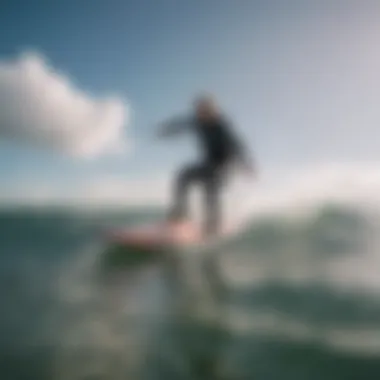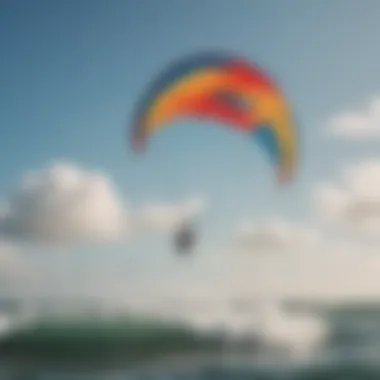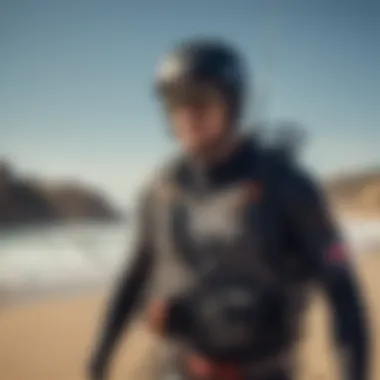Unveiling the Ultimate Guide to Kitesurfing Equipment for Thrilling Adventures


Equipment Reviews
When it comes to kitesurfing, having the right equipment can make or break your experience on the water. Let's dive into the world of kites, where we'll explore the latest models, their features, and performance nuances. From different kite shapes to sizes, materials, and renowned brands, this section will provide a comprehensive overview of what kitesurfers need to soar through the waves with ease and agility.
--
Kitesurfing boards are not just planks; they are meticulously designed pieces of equipment that significantly impact your riding style. Here, we will review various kiteboarding boards, including twintips and directional boards, focusing on their design, construction, and suitability for different riding styles. Whether you're a freestyle enthusiast or a wave rider, understanding the nuances of kiteboarding boards is vital for optimizing your time on the water.
--
Accessories are the unsung heroes of kitesurfing, providing crucial support and safety for riders. In this section, we'll delve into essential kiteboarding accessories like harnesses, lines, pumps, and safety gear, detailing the importance and functionality of each. From ensuring a secure connection to the kite to staying safe in challenging conditions, these accessories play a pivotal role in every kitesurfer's toolkit.
Travel Destinations
Embark on a journey to explore the top kitesurfing and kiteboarding destinations worldwide, where wind and water conditions converge to create a paradise for water sports enthusiasts. Discover popular spots known for their ideal conditions, local amenities, and attractions that cater to kitesurfers seeking both thrill and relaxation.
--
For the intrepid explorers seeking unconventional kitesurfing experiences, we unveil hidden gems and underrated spots that offer a unique blend of tranquility and adrenaline. These off-the-beaten-path destinations promise uncharted kitesurfing adventures, where you can immerse yourself in the beauty of nature and the thrill of challenging winds.
Techniques and Tutorials
Mastering the art of kitesurfing starts with a solid foundation in fundamental techniques. In this section, we provide beginner guides with step-by-step tutorials on launching, riding, turning, and landing techniques, offering novices a comprehensive roadmap to kickstart their kitesurfing journey with confidence and proficiency.
--
For seasoned riders looking to take their skills to the next level, we present detailed instructions on advanced maneuvers such as jumps, tricks, wave riding, and freestyle techniques. From perfecting your aerial stunts to conquering waves with finesse, these tutorials cater to experienced kitesurfers seeking to elevate their performance on the water.
Safety Guidelines
Safety is paramount in kitesurfing, where knowledge and preparedness can mean the difference between a thrilling session and a potential accident. Learn how weather conditions, including wind, currents, tides, and weather patterns, impact kitesurfing safety, and gain valuable tips on assessing and adapting to changing environmental variables.
--
In the event of emergencies on the water, having a clear understanding of rescue tactics and emergency procedures is essential. From basic safety measures to handling common mishaps, this section equips kitesurfers with the knowledge needed to stay safe and secure during their adrenaline-fueled adventures.
--
Proper equipment maintenance is key to ensuring a safe kitesurfing experience. We stress the importance of regular equipment checks, maintenance routines, and safety gear inspections to minimize risks and maximize enjoyment on the water.
Introduction
Kitesurfing is a thrilling water sport that combines elements of surfing and kite flying, offering enthusiasts an adrenaline-fueled experience unlike any other. In this comprehensive guide, we will delve into the world of kitesurfing equipment, equipping you with the knowledge needed to make informed decisions before embarking on your kitesurfing adventures. From choosing the right board to understanding the intricacies of kitesurfing kites and safety gear, this guide has you covered.


Understanding Kitesurfing Equipment
Kitesurfing Boards
Kitesurfing boards are the backbone of your kitesurfing setup, providing stability and control as you ride the waves. Twin-tip boards, such as Freestyle and Freeride Twin-Tips, offer versatility and maneuverability, making them ideal for both tricks and cruising. On the other hand, Directional Boards like Wave and Freeride boards are designed for specific riding styles, excelling in wave conditions or all-around performance.
Kitesurfing Kites
The kitesurfing kite is essentially your engine, powering you across the water with precision and speed. Leading Edge Inflatables (LEI) are popular for their relaunch capabilities and wind range, coming in variations like Freestyle and Freeride kites to suit different riding preferences. Foil kites, including Closed-Cell and Open-Cell variants, offer efficient performance and light wind capabilities, catering to experienced riders seeking speed and agility.
Harness and Lines
Your harness and lines play a crucial role in distributing the kite's power and providing crucial connections between you and the kite. Waist harnesses offer freedom of movement and are favored by freestyle riders, while seat harnesses provide added support and are preferred for long sessions or beginners. Understanding the dynamics of harness and lines ensures a secure and comfortable kitesurfing experience, enhancing both performance and safety on the water.
Kitesurfing Boards
Kitesurfing boards play a pivotal role in the kitesurfing experience, as they act as the crucial interface between the rider and the water. These boards come in various types, each designed to cater to specific riding styles and conditions. Understanding the nuances of different kitesurfing boards is essential for enthusiasts looking to elevate their performance on the water.
Twin-Tip Boards
Twin-tip boards are characterized by their symmetrical shape, allowing riders to move forward and backward without switching directions. Within the realm of twin-tip boards, two main categories stand out: freestyle twin-tips and freeride twin-tips.
Freestyle Twin-Tips
Freestyle twin-tip boards are tailored for riders looking to execute aerial tricks and maneuvers. Their design emphasizes agility and responsiveness, enabling quick transitions and dynamic moves. The key characteristic of freestyle twin-tips lies in their flex pattern, which provides optimal pop and stability during high-flying tricks. Their lightweight construction and sharp edges facilitate precise edging and control, making them a popular choice for riders pushing the boundaries of creativity.
Freeride Twin-Tips
In contrast, freeride twin-tip boards prioritize versatility and comfort for riders seeking a smoother cruising experience. Featuring a more forgiving flex pattern and rounded edges, freeride twin-tips offer a balance of performance and ease of use. The key advantage of freeride twin-tips is their suitability for various conditions, from choppy waters to light winds. While they may not excel in extreme tricks like their freestyle counterparts, freeride twin-tips deliver stability and predictability, making them an attractive option for recreational riders.
Directional Boards
Directional boards, as the name suggests, are designed to be ridden in one direction, with a distinct nose and tail. This specialized design enhances control and maneuverability in the water, particularly in waves. Two primary types of directional boards are wave boards and freeride boards.
Wave Boards
Wave boards are crafted for surfing in dynamic wave conditions, offering responsiveness and agility when navigating challenging swells. Their narrower profile and rocker shape enable quick turns and precise carving, essential for wave enthusiasts looking to maximize their wave-riding potential. The unique feature of wave boards lies in their ability to excel in steep faces and critical sections, providing riders with the means to conquer powerful waves with finesse.
Freeride Boards
On the other hand, freeride boards cater to riders seeking a blend of wave-riding performance and versatility in flatwater conditions. With a wider outline and flatter rocker, freeride boards deliver stability and planing efficiency, ideal for cruising and freestyle maneuvers. The key benefit of freeride boards is their adaptability across various environments, allowing riders to transition seamlessly between wave sailing and freeride excursions. While they may lack the wave-specific finesse of dedicated wave boards, freeride boards offer a well-rounded experience for riders exploring different kitesurfing disciplines.
Kitesurfing Kites
In this Comprehensive Guide to Exploring Kitesurfing Equipment, the section on Kitesurfing Kites holds paramount importance. Kites are the key component in kitesurfing, serving as the driving force behind the sport. They come in various types, each designed to cater to different styles and levels of performance, making them a crucial element to consider when diving into the world of kitesurfing.


Leading Edge Inflatables (LEI)
Freestyle Kites
Freestyle kites, a subset of Leading Edge Inflatables, are renowned for their agility and responsiveness in the air. These kites excel in allowing riders to perform aerial maneuvers, tricks, and stunts with precision and control. Their key characteristic lies in their ability to generate rapid power bursts, enabling riders to catapult into exhilarating jumps and freestyle moves effortlessly. Freestyle kites are a popular choice for adrenaline-seeking riders looking to push the boundaries of their skills and creativity on the water. While they offer unrivaled performance in freestyle tricks, one must be cautious of their power delivery, which can be intense and require a skilled hand to handle effectively.
Freeride Kites
On the other end of the spectrum, freeride kites cater to riders seeking a more relaxed and versatile kitesurfing experience. The key characteristic of freeride kites lies in their balance between stability, ease of use, and all-around performance. These kites are favored for their user-friendly nature, making them ideal for beginners and intermediate riders looking to explore the sport in a more casual manner. Freeride kites offer a smooth and predictable power delivery, allowing riders to cruise effortlessly across the water while enjoying a comfortable and controlled ride experience. While they may lack the extreme agility of freestyle kites, freeride kites excel in providing a stable and consistent performance, enhancing the overall kitesurfing experience for a wide range of enthusiasts.
Foils
Closed-Cell Foils
Closed-cell foils represents a unique category within kitesurfing kites, known for their efficient performance and ease of use. The key characteristic of closed-cell foils lies in their ability to retain air pressure within the cells, leading to quick and easy inflation, enhancing the kite's responsiveness and handling. These foils are a popular choice for riders looking for hassle-free setup and reliable performance on the water. Their unique feature of self-inflation contributes to their fast deployment, making them ideal for riders seeking convenience and efficiency in their kitesurfing adventures. While closed-cell foils offer excellent performance and ease of use, riders should be wary of their reduced maneuverability and agility compared to open-cell foils.
Open-Cell Foils
Open-cell foils stand out as a versatile option in the realm of kitesurfing kites, prized for their combination of performance and safety. The key characteristic of open-cell foils lies in their enhanced depower and stability, making them a popular choice for riders seeking control and security on the water. These foils excel in maintaining a steady power delivery while offering increased safety features such as quick and reliable depowering mechanisms. Their unique feature of improved wind range and depower capabilities enhances the overall kite handling and safety for riders of all levels. While open-cell foils provide excellent stability and safety benefits, riders should consider their reduced efficiency in light wind conditions compared to closed-cell foils.
Safety Gear and Accessories
In the realm of kitesurfing, safety gear and accessories play a pivotal role in ensuring a smooth and secure ride across the waves. These items are not mere add-ons but essential components that can make a significant difference in the overall kitesurfing experience. Harnesses, impact vests, helmets, safety gear like PFDs and safety knives, as well as various accessories such as foot straps, pumps, and repair kits, all collectively contribute to enhancing the safety and enjoyment of the ride. Understanding the nuances of each safety gear and accessory is crucial for kitesurfers to make informed choices that align with their skill level and riding preferences.
Harnesses
Harnesses are key elements in kitesurfing gear, providing riders with the necessary support and control while kiting. There are primarily two types of harnesses commonly used in the sport: waist harnesses and seat harnesses. Each type caters to different preferences and riding styles, offering distinct advantages based on the rider's comfort and requirements. Waist harnesses are favored for their ergonomic design, which provides freedom of movement and flexibility during maneuvers. On the other hand, seat harnesses are preferred for their stability and lower back support, especially beneficial for riders who prioritize comfort and longer sessions on the water.
Waist Harnesses
As a crucial component of kitesurfing equipment, waist harnesses are renowned for their minimalistic design and snug fit around the waist, ensuring unhindered mobility for the rider. The key characteristic of waist harnesses lies in their ability to distribute the kite's pulling force evenly across the body, preventing strain or fatigue during extended sessions. This feature makes waist harnesses a popular choice among riders seeking agility and fluidity in their movements on the water. While waist harnesses are lauded for their comfort and maneuverability, some riders may find them less suitable for prolonged sessions, particularly if lower back support is a primary concern.
Seat Harnesses
Seat harnesses stand out for their supportive structure, offering increased lumbar support and reducing strain on the rider's lower back. The key characteristic of seat harnesses is their ability to provide a secure and stable connection between the rider and the kite, enhancing control and balance during challenging conditions. This makes seat harnesses an ideal choice for riders looking for added comfort and confidence while navigating strong winds and rough waters. However, some riders may find seat harnesses slightly restrictive in terms of mobility compared to waist harnesses, particularly during freestyle maneuvers that require extensive body movement.
Impact Vests
When it comes to safety on the water, impact vests are essential components that provide an extra layer of protection against unforeseen accidents and impacts. These vests come in two main variants: floatation vests and non-floatation vests, each designed to cater to specific needs and preferences of riders. Floatation vests are equipped with buoyant materials that aid in keeping the rider afloat in case of emergencies, making them ideal for beginners and those exploring rough waters. Conversely, non-floatation vests prioritize flexibility and impact resistance, offering riders a greater range of motion without compromising on safety.
Floatation Vests
Floatation vests are characterized by their buoyant properties, designed to provide flotation assistance in emergency situations where the rider needs additional support to stay above water. The key characteristic of floatation vests lies in their ability to offer peace of mind and enhanced safety for riders, especially in challenging conditions or turbulent waters. This feature makes floatation vests a popular choice among newcomers and individuals looking to build confidence in their kitesurfing abilities. However, some riders may find floatation vests slightly bulky or restrictive in terms of movement, particularly during high-speed rides or advanced tricks.
Non-Floatation Vests


On the other hand, non-floatation vests prioritize maneuverability and impact protection, allowing riders to move freely without the added buoyancy of floatation materials. The key characteristic of non-floatation vests is their lightweight and streamlined design, offering riders a comfortable and secure fit that enhances their performance on the water. This feature makes non-floatation vests a preferred choice among experienced kitesurfers seeking maximum mobility and comfort during dynamic riding sessions. However, riders who prioritize buoyancy and flotation assistance may find non-floatation vests lacking in that aspect, requiring them to assess their comfort level and skill proficiency before opting for this variant.
Choosing the Right Equipment
Choosing the right kitesurfing equipment is crucial for an exhilarating and safe experience on the water. The equipment you select can significantly impact your performance, comfort, and overall enjoyment while kitesurfing. It is essential to consider various factors to ensure that you make informed decisions when choosing your gear.
Factors to Consider
Rider Level
Rider level plays a pivotal role in selecting the appropriate kitesurfing equipment. A rider's level of experience and skill directly influences the type of gear that would best suit them. Beginners may require more stable and forgiving equipment that can aid in learning and progress safely. In contrast, advanced riders often prefer high-performance gear that allows for greater speed, control, and maneuverability. Understanding your skill level is essential in choosing equipment that enhances your abilities and matches your riding style.
Wind Conditions
Wind conditions are a critical factor to consider when selecting kitesurfing equipment. The strength and consistency of the wind at your local spot will determine the size and type of kite you need. Lighter winds may necessitate larger kites for optimal power and lift, while stronger winds call for smaller kites to maintain control and prevent overpowering. Being mindful of wind conditions ensures that you select the right kite size to maximize your time on the water and enhance your overall performance.
Water Conditions
Water conditions play a significant role in determining the type of board and kite suitable for your kitesurfing sessions. Choppy waters or waves require boards with sufficient maneuverability and responsiveness to navigate through varying conditions effectively. In calmer waters, stability and speed may take precedence in board selection. Understanding how water conditions impact your riding experience helps in choosing equipment that provides the desired level of control, comfort, and performance.
Seeking Expert Advice
When in doubt about choosing the right kitesurfing equipment, seeking expert advice can provide valuable insights and recommendations. Local shops specializing in watersports often have experienced staff who can assess your needs and guide you towards suitable gear. Their expertise can help you navigate the vast array of equipment options available in the market. Community forums also offer a wealth of knowledge shared by seasoned kitesurfers who can offer personal recommendations based on their experiences. Engaging with experts can streamline the equipment selection process and ensure that you invest in gear that aligns with your skill level and riding preferences.
Maintenance and Care Tips
Maintenance and care tips are crucial in the realm of kitesurfing equipment as they ensure the longevity and optimal performance of gear. With the dynamic nature of this sport, proper upkeep is essential to guarantee safety and efficiency during kitesurfing sessions. By following maintenance and care guidelines, enthusiasts can prolong the lifespan of their equipment, thus maximizing their investment in high-quality gear. Neglecting maintenance can lead to potential risks and equipment failures, hampering the overall kitesurfing experience.
Cleaning and Storage
Rinsing Equipment
Rinsing equipment is a fundamental aspect of equipment care in kitesurfing. By thoroughly rinsing kitesurfing gear after each session, riders can remove salt residue and sand particles that could cause wear and tear over time. This simple yet effective practice helps maintain the integrity of the equipment, preventing corrosion and damage. Regular rinsing also contributes to hygiene and ensures a clean and functional setup for the next kitesurfing adventure. The convenience and benefits of rinsing equipment make it a non-negotiable routine for kitesurfing enthusiasts looking to preserve their gear.
Proper Storage
Proper storage techniques play a pivotal role in kitesurfing equipment maintenance. Storing gear in a cool, dry place away from direct sunlight and extreme temperatures safeguards it from deterioration and deformation. By hanging kites to dry properly before storage and coiling lines neatly to prevent tangling, enthusiasts can maintain the structural integrity of their equipment. Organizing and storing gear systematically not only prolongs its lifespan but also streamlines preparation for future kitesurfing sessions. The discipline of proper storage ensures that gear remains in top condition, ready for optimal performance on the water.
Conclusion
In the realm of kitesurfing equipment, the conclusion acts as a pivotal point that encapsulates the significance of investing time and effort in understanding the gear required for this adrenaline-pumping sport. As kitesurfing hinges greatly on the equipment used, ensuring that you have the right tools is essential for a safe and enjoyable experience on the water. By delving into the nuances of kitesurfing equipment, enthusiasts can not only enhance their performance but also prioritize their safety. In this guide, the importance of selecting quality gear and continually striving for improvement emerges as fundamental principles that can elevate one's kitesurfing journey to new heights.
Enhancing Your Kitesurfing Experience
Investing in Quality Gear
When it comes to kitesurfing, investing in quality gear stands as a cornerstone that underpins the overall experience on the water. Quality gear not only offers superior performance but also guarantees reliability and durability in challenging conditions. The key characteristic of investing in quality gear lies in the craftsmanship and technological advancements incorporated into each piece of equipment. By choosing high-quality kites, boards, harnesses, and safety accessories, kitesurfers can boost their confidence in tackling varying wind and water conditions with ease. The unique feature of quality gear is its ability to withstand rigorous usage while providing optimal functionality, making it a popular choice among serious kitesurfing enthusiasts. While the initial investment may seem significant, the long-term advantages of reliable gear that enhances performance and safety cannot be understated.
Continual Learning and Improvement
Embracing a mindset of continual learning and improvement is paramount in the world of kitesurfing. As a dynamic sport constantly evolving with new techniques and technological innovations, staying abreast of industry trends and honing one's skills are crucial for progression. The key characteristic of continual learning lies in remaining open to feedback, seeking mentorship, and actively engaging in training to enhance proficiency. This approach not only sharpens kitesurfing abilities but also fosters a deeper understanding of the sport's intricacies. The unique feature of continual improvement is its ability to unlock new possibilities and push boundaries, propelling kitesurfers towards mastery. While the process may pose challenges and setbacks, the advantages of continual learning in refining techniques, conquering new tricks, and unleashing creativity make it a worthwhile pursuit in enriching the kitesurfing experience.







